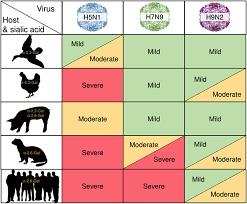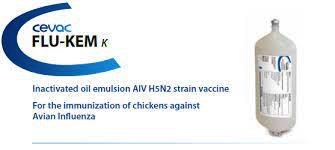 Scientists at the University of Glasgow, Center for Virus Research have evaluated the genetic factors associated with resistance of humans to avian influenza viruses. It was established that a gene designated BTN3A3 expressed in mucosal cells of the human respiratory tract are responsible for a protein that blocks replication of many strains of avian influenza in vitro in cell indicator systems. Human strains of influenza are unaffected by the presence of the gene as was the case with the virus responsible for the 1918-19 pandemic. Despite the ongoing panornitic of H5N1 avian influenza there have been few documented cases of infection in humans and no evidence of human-to-human spread.
Scientists at the University of Glasgow, Center for Virus Research have evaluated the genetic factors associated with resistance of humans to avian influenza viruses. It was established that a gene designated BTN3A3 expressed in mucosal cells of the human respiratory tract are responsible for a protein that blocks replication of many strains of avian influenza in vitro in cell indicator systems. Human strains of influenza are unaffected by the presence of the gene as was the case with the virus responsible for the 1918-19 pandemic. Despite the ongoing panornitic of H5N1 avian influenza there have been few documented cases of infection in humans and no evidence of human-to-human spread.
 The H5N1virus has been isolated from terrestrial free-living mammals contracting the disease, presumably from consuming dead infected wild birds. More recently, there is evidence that mink-to-mink transmission occurred on a farm in Spain and there is also a presumption that cat-to-cat transmission may be occurring among feral cats in Poland given the extent of infection and the incidence rate. At this stage there is no explanation for high mortality in marine mammals along the coast of Peru or for the sporadic cases on the shores of three continents
The H5N1virus has been isolated from terrestrial free-living mammals contracting the disease, presumably from consuming dead infected wild birds. More recently, there is evidence that mink-to-mink transmission occurred on a farm in Spain and there is also a presumption that cat-to-cat transmission may be occurring among feral cats in Poland given the extent of infection and the incidence rate. At this stage there is no explanation for high mortality in marine mammals along the coast of Peru or for the sporadic cases on the shores of three continents
Examination of H5N1 isolates indicates that half of the strains evaluated are resistant to proteins coded by BTN3A3. This situation represents a potential risk of H5N1 becoming a zoonotic infection should additional mutations occur in the H5N1 genome.
 Given that wild migratory birds serve as both reservoirs and disseminators of the virus that has been identified on five continents since 2020, suppression of the infection in commercial poultry is considered necessary to prevent a potential zoonosis. The traditional approach to control of avian influenza involves rapid diagnosis, flock depletion, quarantine and surveillance. These measures have been unsuccessful in eradicating avian influenza in Asia, Africa, Europe and the Americas. It is becoming apparent that avian influenza is seasonally and regionally endemic in many regions with large commercial poultry populations. Alternative strategies incorporating immunization should be adopted as an adjunct to biosecurity to control persistence of infection in poultry and to prevent the possible emergence of a zoonotic infection.
Given that wild migratory birds serve as both reservoirs and disseminators of the virus that has been identified on five continents since 2020, suppression of the infection in commercial poultry is considered necessary to prevent a potential zoonosis. The traditional approach to control of avian influenza involves rapid diagnosis, flock depletion, quarantine and surveillance. These measures have been unsuccessful in eradicating avian influenza in Asia, Africa, Europe and the Americas. It is becoming apparent that avian influenza is seasonally and regionally endemic in many regions with large commercial poultry populations. Alternative strategies incorporating immunization should be adopted as an adjunct to biosecurity to control persistence of infection in poultry and to prevent the possible emergence of a zoonotic infection.